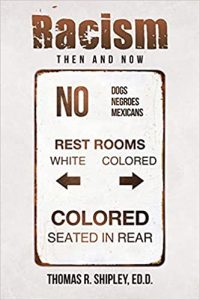
At 87, Thomas R. Shipley has been a lot of places and done a lot of things.
The Mt. Royal Avenue resident grew up and raised a family in what he calls “a bigoted, rural redneck environment” in Caroline County farm country. “I had no intention of being poor like others in my family, so I got an education,” he said, earning first a degree in agriculture and, eventually, a Doctor of Education degree.
What followed were successful stretches at raising crops, working as a musician and teacher, marriage and raising a family, founding and operating profitable small businesses, and a long stretch in public education and administration for the state’s Department of Education.
 Now he has written a provocative and opinionated book. He wants young Black people (and anyone else) in and out of school to read it and to argue with him about his contention that contemporary racism is much more benign and less common than when he was younger.
Now he has written a provocative and opinionated book. He wants young Black people (and anyone else) in and out of school to read it and to argue with him about his contention that contemporary racism is much more benign and less common than when he was younger.
Racism Then and Now, published by Page Publishing in Pennsylvania, is Shipley’s assessment of how young African Americans in Baltimore and everywhere need to seize the opportunities available to them and to develop social strengths and marketable skills instead of claiming entitlements. To get to this argument, he looks back on his own childhood and to the injustices all around him where Black people were involved.
He recalls a family retainer, Bessie Johnson, who cooked, kept house, did laundry, midwifed, and helped raise first his mother from childhood and then his mother’s family, including himself. While living with her partner and her own three children in poverty, Bessie Johnson brought love, patience, and stability to Shipley’s boyhood, and taught him important skills and truths. Yet she was never allowed to join the family at the table she set for them. She said she understood, and kept to “her place,” or so he was taught.
That era of Jim Crow laws, overt segregation, economic confinement, random violence and lynching against Black and immigrant families was a product of legislated and enforced racial discrimination. The denial of education to most Black people was “baked into our everyday ways of life,” Shipley writes. Today is different, he correctly asserts, but then he wades into a complex argument about institutional bigotry versus individual racism that is destined to be a hard sell to many.
Young people whose families live today in poverty and struggle to keep up because of a legacy of, for example, school and housing segregation and redlining that kept them from access to mortgages, home ownership and wealth accumulation are likely to scoff at Shipley’s belief that in this era of diversity all around us “there is no such thing as a ‘neglected minority’; there are only neglected individuals and that is mostly self-imposed.”
He writes: “the discriminatory divide … once all about race is now more and more driven by economics, education and personal behavior.” Doors to success that were long closed are now opened to disciplined, educated and ambitious Black men and women, he contends. Without marketable skills and social graces, both attainable, too many young people today invite social and professional rejection, Shipley writes.
He invites you to read his book and argue with him. “I know it’s not going to be well reviewed by some,” he says.
Although gay, Shipley says he has not experienced the discomfort of discrimination. He lives in Bolton Hill with his partner of 26 years, Chris Taylor. He has volunteered to work with students at historically Black colleges in the region and now counsels budding entrepreneurs, working with mostly Black students and graduates at the University of Baltimore’s School of Business.
Racism Then and Now is available at Barnes & Noble, Amazon and other book sellers and through http://thomshipleybooks.com/.
–Bill Hamilton
